Conflict Management Strategies and Managerial Implications Report
VerifiedAdded on 2020/05/16
|11
|2835
|361
Report
AI Summary
This report delves into the multifaceted realm of managerial conflict within organizations, exploring its various dimensions and implications. It begins by defining conflict and conflict management, highlighting the inevitable nature of disagreements in organizational settings. The report then examines the challenges managers face when dealing with interface conflicts, such as limited resources, departmentalization, role expectations, environmental changes, communication breakdowns, unethical behavior, and team dynamics. It outlines several conflict management strategies, including accommodating, avoiding, compromising, competing, and collaborating. Finally, the report analyzes the managerial implications of conflicts, including deteriorated communication, ineffective time management, decreased productivity, negative work environments, and high employee attrition. The report underscores the importance of effective conflict management for organizational success and provides insights into mitigating the negative consequences of workplace conflicts.
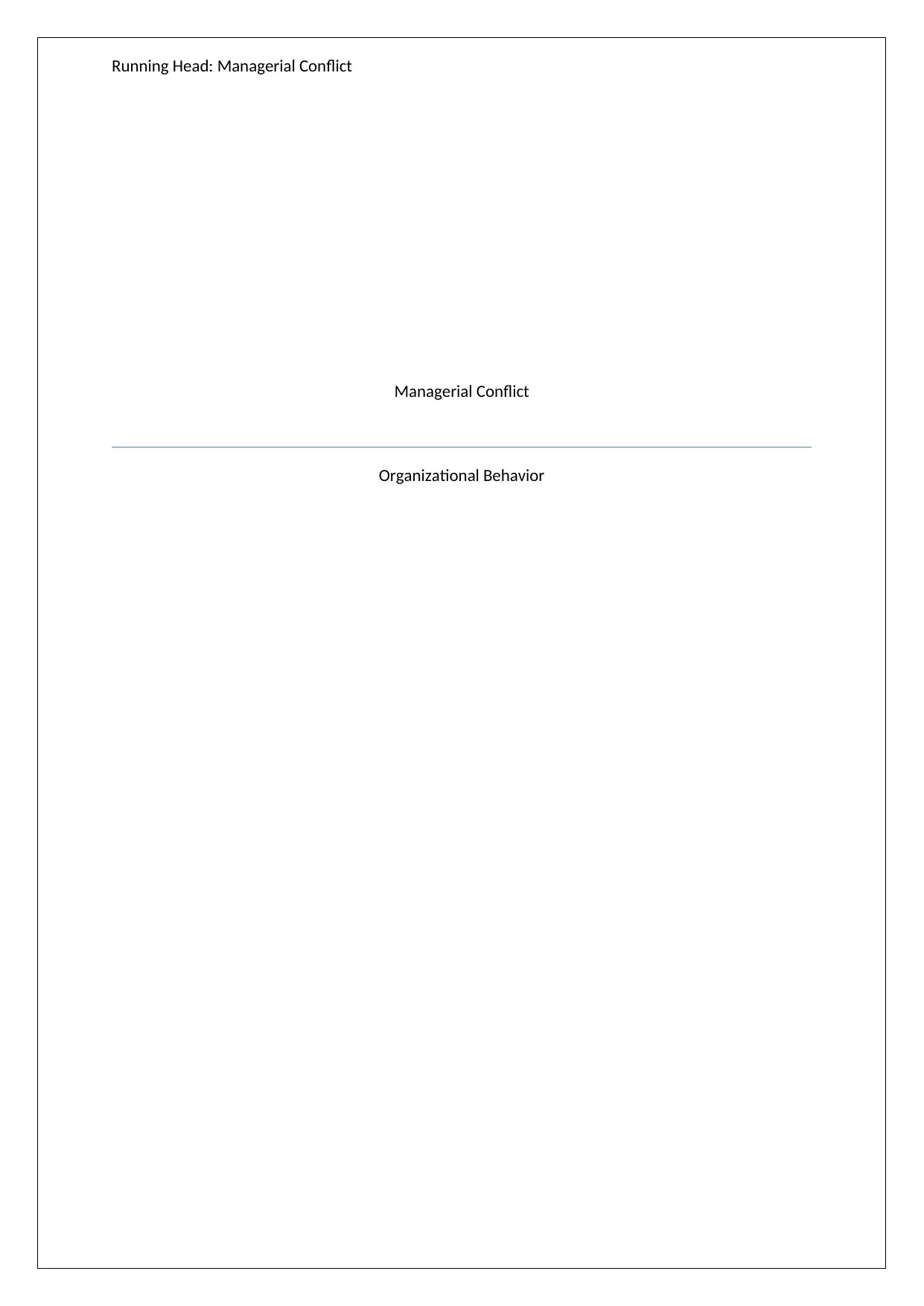
Running Head: Managerial Conflict
Managerial Conflict
Organizational Behavior
Managerial Conflict
Organizational Behavior
Paraphrase This Document
Need a fresh take? Get an instant paraphrase of this document with our AI Paraphraser
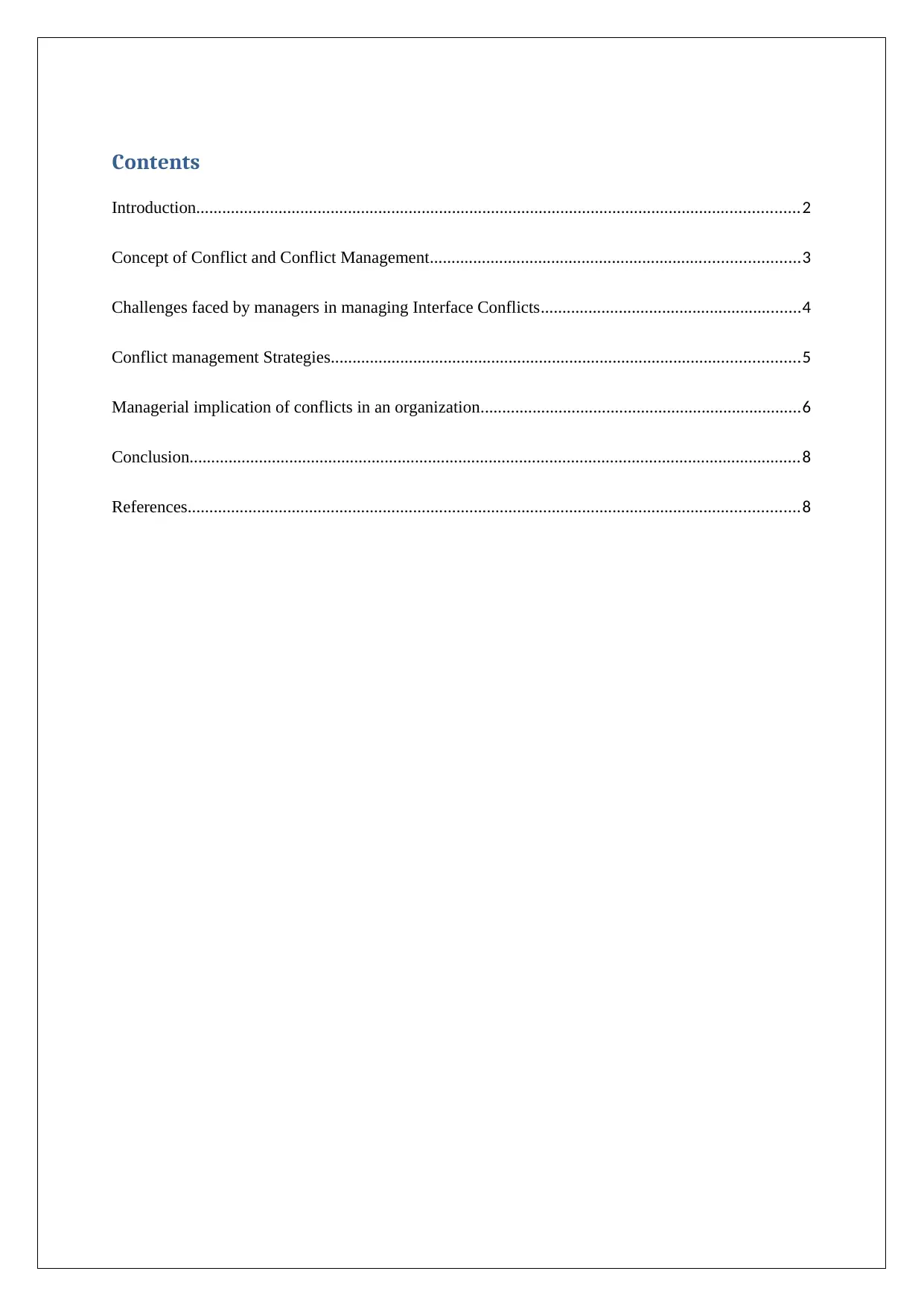
Contents
Introduction...........................................................................................................................................2
Concept of Conflict and Conflict Management.....................................................................................3
Challenges faced by managers in managing Interface Conflicts............................................................4
Conflict management Strategies............................................................................................................5
Managerial implication of conflicts in an organization..........................................................................6
Conclusion.............................................................................................................................................8
References.............................................................................................................................................8
Introduction...........................................................................................................................................2
Concept of Conflict and Conflict Management.....................................................................................3
Challenges faced by managers in managing Interface Conflicts............................................................4
Conflict management Strategies............................................................................................................5
Managerial implication of conflicts in an organization..........................................................................6
Conclusion.............................................................................................................................................8
References.............................................................................................................................................8
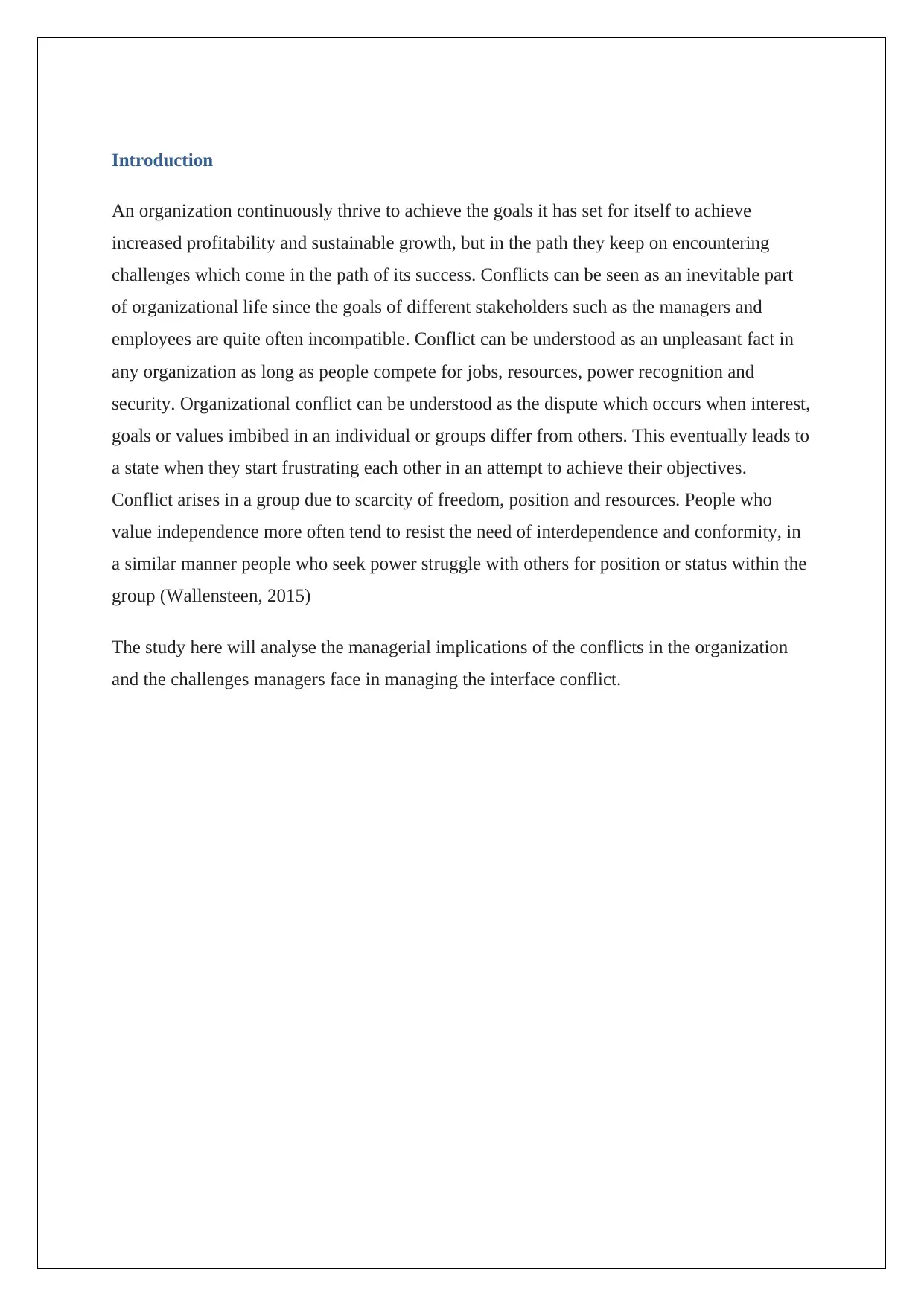
Introduction
An organization continuously thrive to achieve the goals it has set for itself to achieve
increased profitability and sustainable growth, but in the path they keep on encountering
challenges which come in the path of its success. Conflicts can be seen as an inevitable part
of organizational life since the goals of different stakeholders such as the managers and
employees are quite often incompatible. Conflict can be understood as an unpleasant fact in
any organization as long as people compete for jobs, resources, power recognition and
security. Organizational conflict can be understood as the dispute which occurs when interest,
goals or values imbibed in an individual or groups differ from others. This eventually leads to
a state when they start frustrating each other in an attempt to achieve their objectives.
Conflict arises in a group due to scarcity of freedom, position and resources. People who
value independence more often tend to resist the need of interdependence and conformity, in
a similar manner people who seek power struggle with others for position or status within the
group (Wallensteen, 2015)
The study here will analyse the managerial implications of the conflicts in the organization
and the challenges managers face in managing the interface conflict.
An organization continuously thrive to achieve the goals it has set for itself to achieve
increased profitability and sustainable growth, but in the path they keep on encountering
challenges which come in the path of its success. Conflicts can be seen as an inevitable part
of organizational life since the goals of different stakeholders such as the managers and
employees are quite often incompatible. Conflict can be understood as an unpleasant fact in
any organization as long as people compete for jobs, resources, power recognition and
security. Organizational conflict can be understood as the dispute which occurs when interest,
goals or values imbibed in an individual or groups differ from others. This eventually leads to
a state when they start frustrating each other in an attempt to achieve their objectives.
Conflict arises in a group due to scarcity of freedom, position and resources. People who
value independence more often tend to resist the need of interdependence and conformity, in
a similar manner people who seek power struggle with others for position or status within the
group (Wallensteen, 2015)
The study here will analyse the managerial implications of the conflicts in the organization
and the challenges managers face in managing the interface conflict.
⊘ This is a preview!⊘
Do you want full access?
Subscribe today to unlock all pages.

Trusted by 1+ million students worldwide
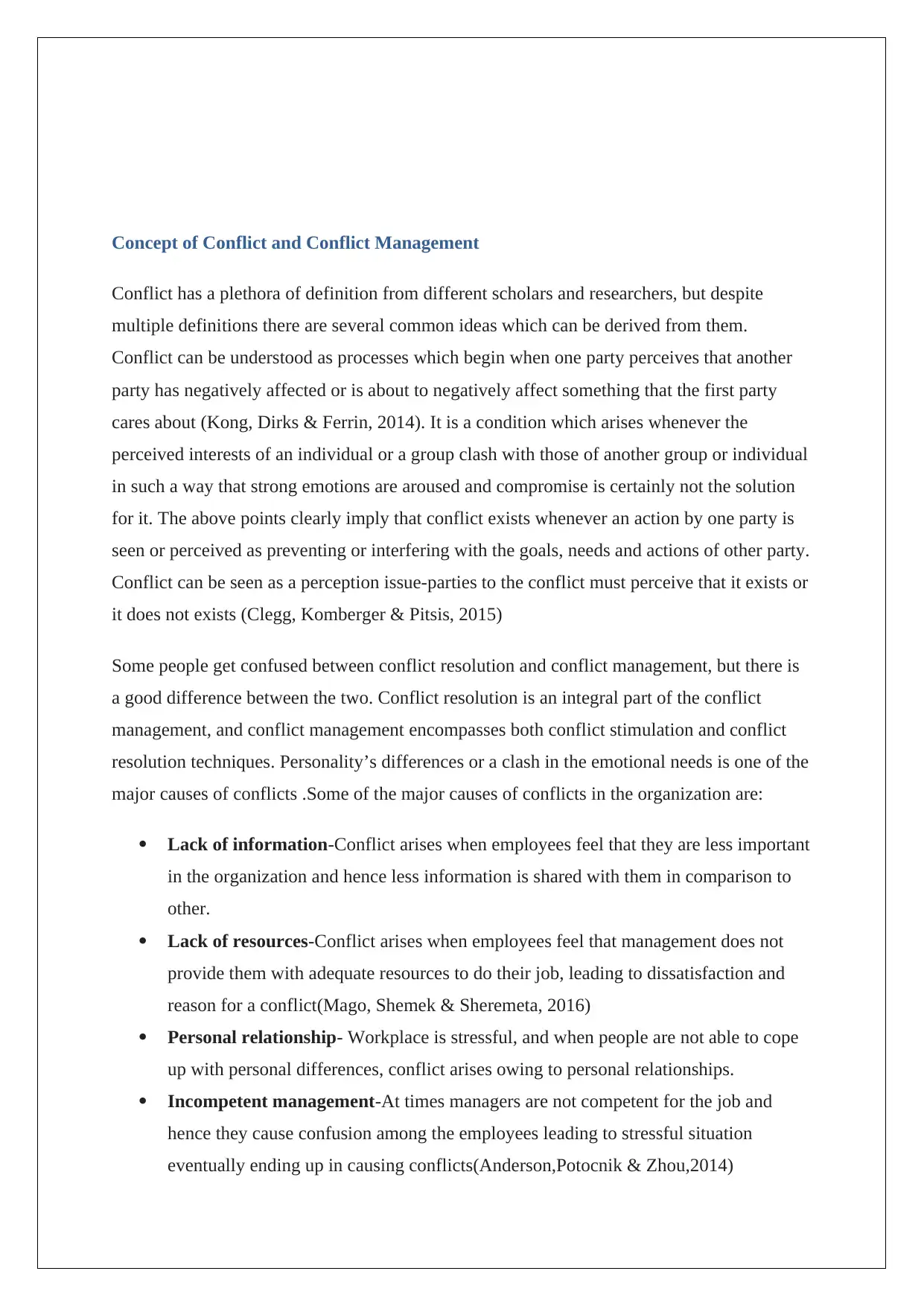
Concept of Conflict and Conflict Management
Conflict has a plethora of definition from different scholars and researchers, but despite
multiple definitions there are several common ideas which can be derived from them.
Conflict can be understood as processes which begin when one party perceives that another
party has negatively affected or is about to negatively affect something that the first party
cares about (Kong, Dirks & Ferrin, 2014). It is a condition which arises whenever the
perceived interests of an individual or a group clash with those of another group or individual
in such a way that strong emotions are aroused and compromise is certainly not the solution
for it. The above points clearly imply that conflict exists whenever an action by one party is
seen or perceived as preventing or interfering with the goals, needs and actions of other party.
Conflict can be seen as a perception issue-parties to the conflict must perceive that it exists or
it does not exists (Clegg, Komberger & Pitsis, 2015)
Some people get confused between conflict resolution and conflict management, but there is
a good difference between the two. Conflict resolution is an integral part of the conflict
management, and conflict management encompasses both conflict stimulation and conflict
resolution techniques. Personality’s differences or a clash in the emotional needs is one of the
major causes of conflicts .Some of the major causes of conflicts in the organization are:
Lack of information-Conflict arises when employees feel that they are less important
in the organization and hence less information is shared with them in comparison to
other.
Lack of resources-Conflict arises when employees feel that management does not
provide them with adequate resources to do their job, leading to dissatisfaction and
reason for a conflict(Mago, Shemek & Sheremeta, 2016)
Personal relationship- Workplace is stressful, and when people are not able to cope
up with personal differences, conflict arises owing to personal relationships.
Incompetent management-At times managers are not competent for the job and
hence they cause confusion among the employees leading to stressful situation
eventually ending up in causing conflicts(Anderson,Potocnik & Zhou,2014)
Conflict has a plethora of definition from different scholars and researchers, but despite
multiple definitions there are several common ideas which can be derived from them.
Conflict can be understood as processes which begin when one party perceives that another
party has negatively affected or is about to negatively affect something that the first party
cares about (Kong, Dirks & Ferrin, 2014). It is a condition which arises whenever the
perceived interests of an individual or a group clash with those of another group or individual
in such a way that strong emotions are aroused and compromise is certainly not the solution
for it. The above points clearly imply that conflict exists whenever an action by one party is
seen or perceived as preventing or interfering with the goals, needs and actions of other party.
Conflict can be seen as a perception issue-parties to the conflict must perceive that it exists or
it does not exists (Clegg, Komberger & Pitsis, 2015)
Some people get confused between conflict resolution and conflict management, but there is
a good difference between the two. Conflict resolution is an integral part of the conflict
management, and conflict management encompasses both conflict stimulation and conflict
resolution techniques. Personality’s differences or a clash in the emotional needs is one of the
major causes of conflicts .Some of the major causes of conflicts in the organization are:
Lack of information-Conflict arises when employees feel that they are less important
in the organization and hence less information is shared with them in comparison to
other.
Lack of resources-Conflict arises when employees feel that management does not
provide them with adequate resources to do their job, leading to dissatisfaction and
reason for a conflict(Mago, Shemek & Sheremeta, 2016)
Personal relationship- Workplace is stressful, and when people are not able to cope
up with personal differences, conflict arises owing to personal relationships.
Incompetent management-At times managers are not competent for the job and
hence they cause confusion among the employees leading to stressful situation
eventually ending up in causing conflicts(Anderson,Potocnik & Zhou,2014)
Paraphrase This Document
Need a fresh take? Get an instant paraphrase of this document with our AI Paraphraser
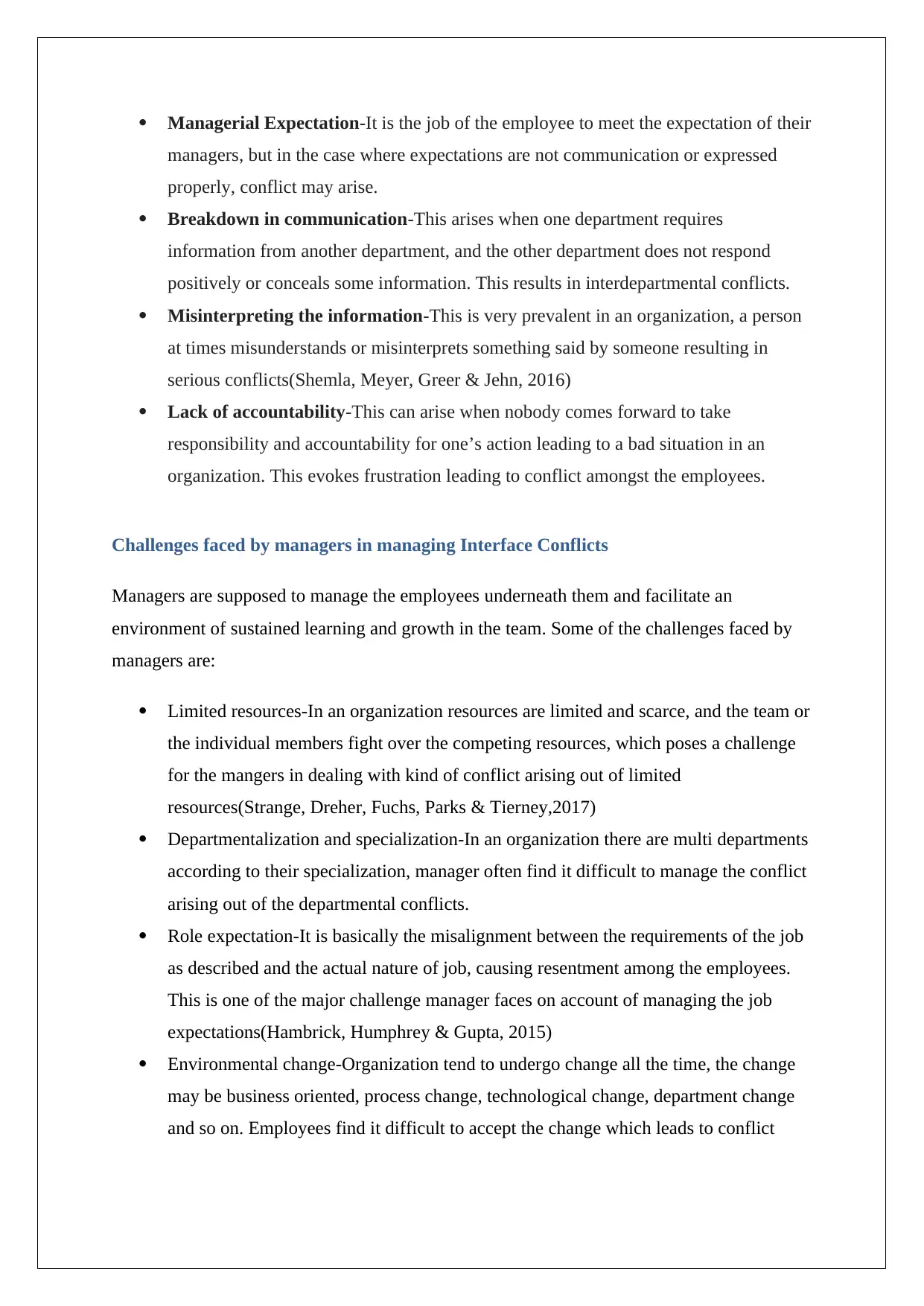
Managerial Expectation-It is the job of the employee to meet the expectation of their
managers, but in the case where expectations are not communication or expressed
properly, conflict may arise.
Breakdown in communication-This arises when one department requires
information from another department, and the other department does not respond
positively or conceals some information. This results in interdepartmental conflicts.
Misinterpreting the information-This is very prevalent in an organization, a person
at times misunderstands or misinterprets something said by someone resulting in
serious conflicts(Shemla, Meyer, Greer & Jehn, 2016)
Lack of accountability-This can arise when nobody comes forward to take
responsibility and accountability for one’s action leading to a bad situation in an
organization. This evokes frustration leading to conflict amongst the employees.
Challenges faced by managers in managing Interface Conflicts
Managers are supposed to manage the employees underneath them and facilitate an
environment of sustained learning and growth in the team. Some of the challenges faced by
managers are:
Limited resources-In an organization resources are limited and scarce, and the team or
the individual members fight over the competing resources, which poses a challenge
for the mangers in dealing with kind of conflict arising out of limited
resources(Strange, Dreher, Fuchs, Parks & Tierney,2017)
Departmentalization and specialization-In an organization there are multi departments
according to their specialization, manager often find it difficult to manage the conflict
arising out of the departmental conflicts.
Role expectation-It is basically the misalignment between the requirements of the job
as described and the actual nature of job, causing resentment among the employees.
This is one of the major challenge manager faces on account of managing the job
expectations(Hambrick, Humphrey & Gupta, 2015)
Environmental change-Organization tend to undergo change all the time, the change
may be business oriented, process change, technological change, department change
and so on. Employees find it difficult to accept the change which leads to conflict
managers, but in the case where expectations are not communication or expressed
properly, conflict may arise.
Breakdown in communication-This arises when one department requires
information from another department, and the other department does not respond
positively or conceals some information. This results in interdepartmental conflicts.
Misinterpreting the information-This is very prevalent in an organization, a person
at times misunderstands or misinterprets something said by someone resulting in
serious conflicts(Shemla, Meyer, Greer & Jehn, 2016)
Lack of accountability-This can arise when nobody comes forward to take
responsibility and accountability for one’s action leading to a bad situation in an
organization. This evokes frustration leading to conflict amongst the employees.
Challenges faced by managers in managing Interface Conflicts
Managers are supposed to manage the employees underneath them and facilitate an
environment of sustained learning and growth in the team. Some of the challenges faced by
managers are:
Limited resources-In an organization resources are limited and scarce, and the team or
the individual members fight over the competing resources, which poses a challenge
for the mangers in dealing with kind of conflict arising out of limited
resources(Strange, Dreher, Fuchs, Parks & Tierney,2017)
Departmentalization and specialization-In an organization there are multi departments
according to their specialization, manager often find it difficult to manage the conflict
arising out of the departmental conflicts.
Role expectation-It is basically the misalignment between the requirements of the job
as described and the actual nature of job, causing resentment among the employees.
This is one of the major challenge manager faces on account of managing the job
expectations(Hambrick, Humphrey & Gupta, 2015)
Environmental change-Organization tend to undergo change all the time, the change
may be business oriented, process change, technological change, department change
and so on. Employees find it difficult to accept the change which leads to conflict
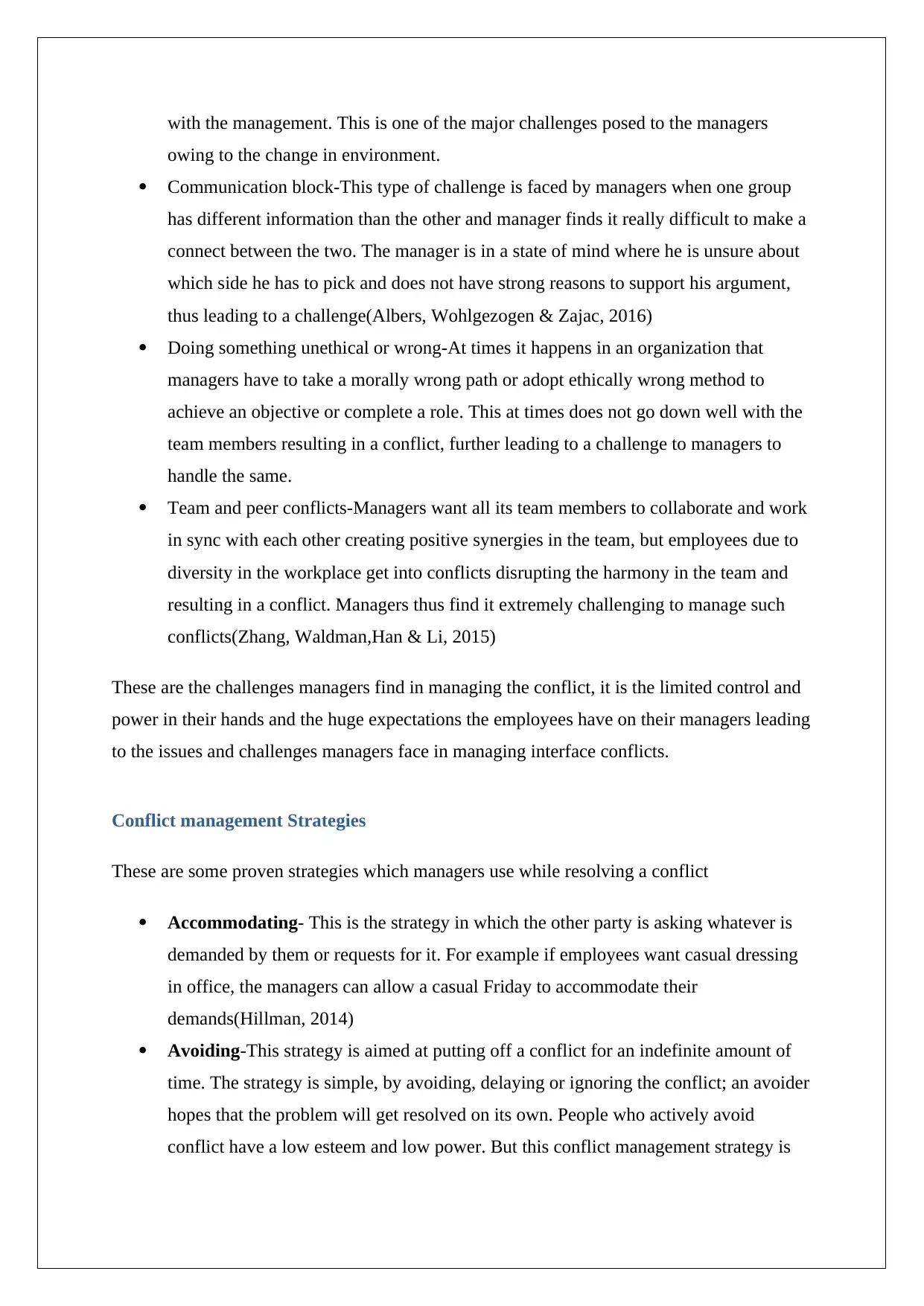
with the management. This is one of the major challenges posed to the managers
owing to the change in environment.
Communication block-This type of challenge is faced by managers when one group
has different information than the other and manager finds it really difficult to make a
connect between the two. The manager is in a state of mind where he is unsure about
which side he has to pick and does not have strong reasons to support his argument,
thus leading to a challenge(Albers, Wohlgezogen & Zajac, 2016)
Doing something unethical or wrong-At times it happens in an organization that
managers have to take a morally wrong path or adopt ethically wrong method to
achieve an objective or complete a role. This at times does not go down well with the
team members resulting in a conflict, further leading to a challenge to managers to
handle the same.
Team and peer conflicts-Managers want all its team members to collaborate and work
in sync with each other creating positive synergies in the team, but employees due to
diversity in the workplace get into conflicts disrupting the harmony in the team and
resulting in a conflict. Managers thus find it extremely challenging to manage such
conflicts(Zhang, Waldman,Han & Li, 2015)
These are the challenges managers find in managing the conflict, it is the limited control and
power in their hands and the huge expectations the employees have on their managers leading
to the issues and challenges managers face in managing interface conflicts.
Conflict management Strategies
These are some proven strategies which managers use while resolving a conflict
Accommodating- This is the strategy in which the other party is asking whatever is
demanded by them or requests for it. For example if employees want casual dressing
in office, the managers can allow a casual Friday to accommodate their
demands(Hillman, 2014)
Avoiding-This strategy is aimed at putting off a conflict for an indefinite amount of
time. The strategy is simple, by avoiding, delaying or ignoring the conflict; an avoider
hopes that the problem will get resolved on its own. People who actively avoid
conflict have a low esteem and low power. But this conflict management strategy is
owing to the change in environment.
Communication block-This type of challenge is faced by managers when one group
has different information than the other and manager finds it really difficult to make a
connect between the two. The manager is in a state of mind where he is unsure about
which side he has to pick and does not have strong reasons to support his argument,
thus leading to a challenge(Albers, Wohlgezogen & Zajac, 2016)
Doing something unethical or wrong-At times it happens in an organization that
managers have to take a morally wrong path or adopt ethically wrong method to
achieve an objective or complete a role. This at times does not go down well with the
team members resulting in a conflict, further leading to a challenge to managers to
handle the same.
Team and peer conflicts-Managers want all its team members to collaborate and work
in sync with each other creating positive synergies in the team, but employees due to
diversity in the workplace get into conflicts disrupting the harmony in the team and
resulting in a conflict. Managers thus find it extremely challenging to manage such
conflicts(Zhang, Waldman,Han & Li, 2015)
These are the challenges managers find in managing the conflict, it is the limited control and
power in their hands and the huge expectations the employees have on their managers leading
to the issues and challenges managers face in managing interface conflicts.
Conflict management Strategies
These are some proven strategies which managers use while resolving a conflict
Accommodating- This is the strategy in which the other party is asking whatever is
demanded by them or requests for it. For example if employees want casual dressing
in office, the managers can allow a casual Friday to accommodate their
demands(Hillman, 2014)
Avoiding-This strategy is aimed at putting off a conflict for an indefinite amount of
time. The strategy is simple, by avoiding, delaying or ignoring the conflict; an avoider
hopes that the problem will get resolved on its own. People who actively avoid
conflict have a low esteem and low power. But this conflict management strategy is
⊘ This is a preview!⊘
Do you want full access?
Subscribe today to unlock all pages.

Trusted by 1+ million students worldwide
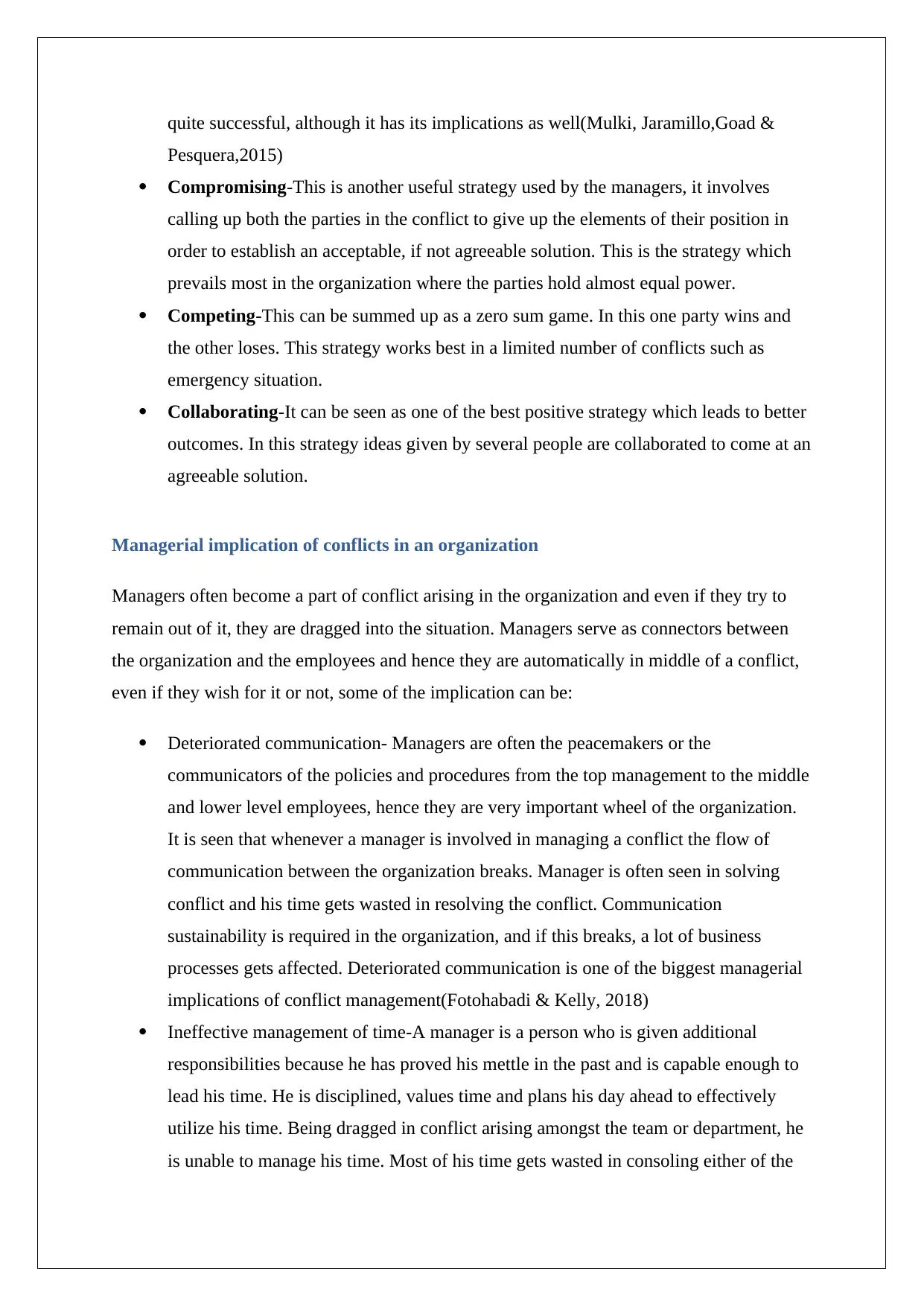
quite successful, although it has its implications as well(Mulki, Jaramillo,Goad &
Pesquera,2015)
Compromising-This is another useful strategy used by the managers, it involves
calling up both the parties in the conflict to give up the elements of their position in
order to establish an acceptable, if not agreeable solution. This is the strategy which
prevails most in the organization where the parties hold almost equal power.
Competing-This can be summed up as a zero sum game. In this one party wins and
the other loses. This strategy works best in a limited number of conflicts such as
emergency situation.
Collaborating-It can be seen as one of the best positive strategy which leads to better
outcomes. In this strategy ideas given by several people are collaborated to come at an
agreeable solution.
Managerial implication of conflicts in an organization
Managers often become a part of conflict arising in the organization and even if they try to
remain out of it, they are dragged into the situation. Managers serve as connectors between
the organization and the employees and hence they are automatically in middle of a conflict,
even if they wish for it or not, some of the implication can be:
Deteriorated communication- Managers are often the peacemakers or the
communicators of the policies and procedures from the top management to the middle
and lower level employees, hence they are very important wheel of the organization.
It is seen that whenever a manager is involved in managing a conflict the flow of
communication between the organization breaks. Manager is often seen in solving
conflict and his time gets wasted in resolving the conflict. Communication
sustainability is required in the organization, and if this breaks, a lot of business
processes gets affected. Deteriorated communication is one of the biggest managerial
implications of conflict management(Fotohabadi & Kelly, 2018)
Ineffective management of time-A manager is a person who is given additional
responsibilities because he has proved his mettle in the past and is capable enough to
lead his time. He is disciplined, values time and plans his day ahead to effectively
utilize his time. Being dragged in conflict arising amongst the team or department, he
is unable to manage his time. Most of his time gets wasted in consoling either of the
Pesquera,2015)
Compromising-This is another useful strategy used by the managers, it involves
calling up both the parties in the conflict to give up the elements of their position in
order to establish an acceptable, if not agreeable solution. This is the strategy which
prevails most in the organization where the parties hold almost equal power.
Competing-This can be summed up as a zero sum game. In this one party wins and
the other loses. This strategy works best in a limited number of conflicts such as
emergency situation.
Collaborating-It can be seen as one of the best positive strategy which leads to better
outcomes. In this strategy ideas given by several people are collaborated to come at an
agreeable solution.
Managerial implication of conflicts in an organization
Managers often become a part of conflict arising in the organization and even if they try to
remain out of it, they are dragged into the situation. Managers serve as connectors between
the organization and the employees and hence they are automatically in middle of a conflict,
even if they wish for it or not, some of the implication can be:
Deteriorated communication- Managers are often the peacemakers or the
communicators of the policies and procedures from the top management to the middle
and lower level employees, hence they are very important wheel of the organization.
It is seen that whenever a manager is involved in managing a conflict the flow of
communication between the organization breaks. Manager is often seen in solving
conflict and his time gets wasted in resolving the conflict. Communication
sustainability is required in the organization, and if this breaks, a lot of business
processes gets affected. Deteriorated communication is one of the biggest managerial
implications of conflict management(Fotohabadi & Kelly, 2018)
Ineffective management of time-A manager is a person who is given additional
responsibilities because he has proved his mettle in the past and is capable enough to
lead his time. He is disciplined, values time and plans his day ahead to effectively
utilize his time. Being dragged in conflict arising amongst the team or department, he
is unable to manage his time. Most of his time gets wasted in consoling either of the
Paraphrase This Document
Need a fresh take? Get an instant paraphrase of this document with our AI Paraphraser
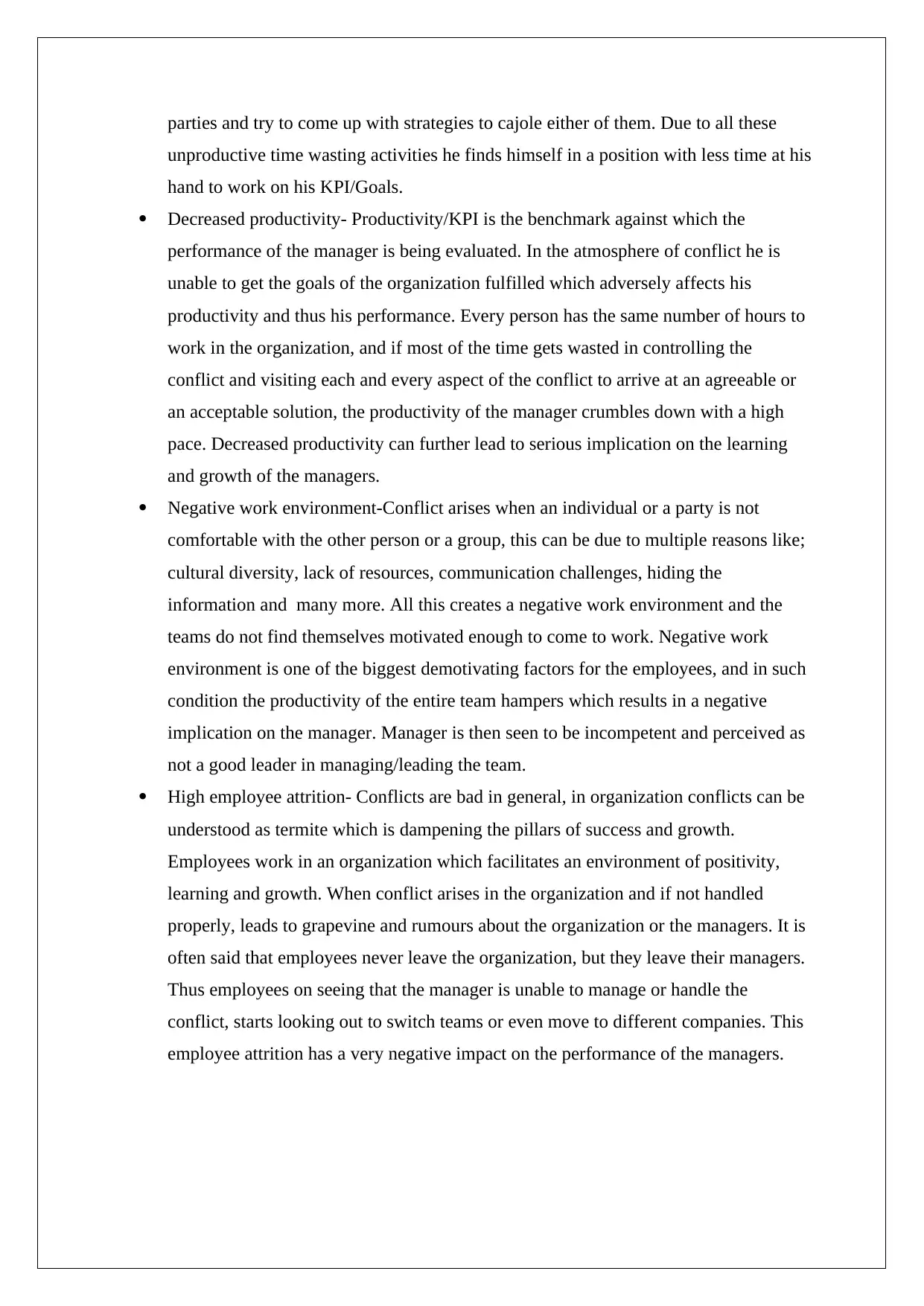
parties and try to come up with strategies to cajole either of them. Due to all these
unproductive time wasting activities he finds himself in a position with less time at his
hand to work on his KPI/Goals.
Decreased productivity- Productivity/KPI is the benchmark against which the
performance of the manager is being evaluated. In the atmosphere of conflict he is
unable to get the goals of the organization fulfilled which adversely affects his
productivity and thus his performance. Every person has the same number of hours to
work in the organization, and if most of the time gets wasted in controlling the
conflict and visiting each and every aspect of the conflict to arrive at an agreeable or
an acceptable solution, the productivity of the manager crumbles down with a high
pace. Decreased productivity can further lead to serious implication on the learning
and growth of the managers.
Negative work environment-Conflict arises when an individual or a party is not
comfortable with the other person or a group, this can be due to multiple reasons like;
cultural diversity, lack of resources, communication challenges, hiding the
information and many more. All this creates a negative work environment and the
teams do not find themselves motivated enough to come to work. Negative work
environment is one of the biggest demotivating factors for the employees, and in such
condition the productivity of the entire team hampers which results in a negative
implication on the manager. Manager is then seen to be incompetent and perceived as
not a good leader in managing/leading the team.
High employee attrition- Conflicts are bad in general, in organization conflicts can be
understood as termite which is dampening the pillars of success and growth.
Employees work in an organization which facilitates an environment of positivity,
learning and growth. When conflict arises in the organization and if not handled
properly, leads to grapevine and rumours about the organization or the managers. It is
often said that employees never leave the organization, but they leave their managers.
Thus employees on seeing that the manager is unable to manage or handle the
conflict, starts looking out to switch teams or even move to different companies. This
employee attrition has a very negative impact on the performance of the managers.
unproductive time wasting activities he finds himself in a position with less time at his
hand to work on his KPI/Goals.
Decreased productivity- Productivity/KPI is the benchmark against which the
performance of the manager is being evaluated. In the atmosphere of conflict he is
unable to get the goals of the organization fulfilled which adversely affects his
productivity and thus his performance. Every person has the same number of hours to
work in the organization, and if most of the time gets wasted in controlling the
conflict and visiting each and every aspect of the conflict to arrive at an agreeable or
an acceptable solution, the productivity of the manager crumbles down with a high
pace. Decreased productivity can further lead to serious implication on the learning
and growth of the managers.
Negative work environment-Conflict arises when an individual or a party is not
comfortable with the other person or a group, this can be due to multiple reasons like;
cultural diversity, lack of resources, communication challenges, hiding the
information and many more. All this creates a negative work environment and the
teams do not find themselves motivated enough to come to work. Negative work
environment is one of the biggest demotivating factors for the employees, and in such
condition the productivity of the entire team hampers which results in a negative
implication on the manager. Manager is then seen to be incompetent and perceived as
not a good leader in managing/leading the team.
High employee attrition- Conflicts are bad in general, in organization conflicts can be
understood as termite which is dampening the pillars of success and growth.
Employees work in an organization which facilitates an environment of positivity,
learning and growth. When conflict arises in the organization and if not handled
properly, leads to grapevine and rumours about the organization or the managers. It is
often said that employees never leave the organization, but they leave their managers.
Thus employees on seeing that the manager is unable to manage or handle the
conflict, starts looking out to switch teams or even move to different companies. This
employee attrition has a very negative impact on the performance of the managers.
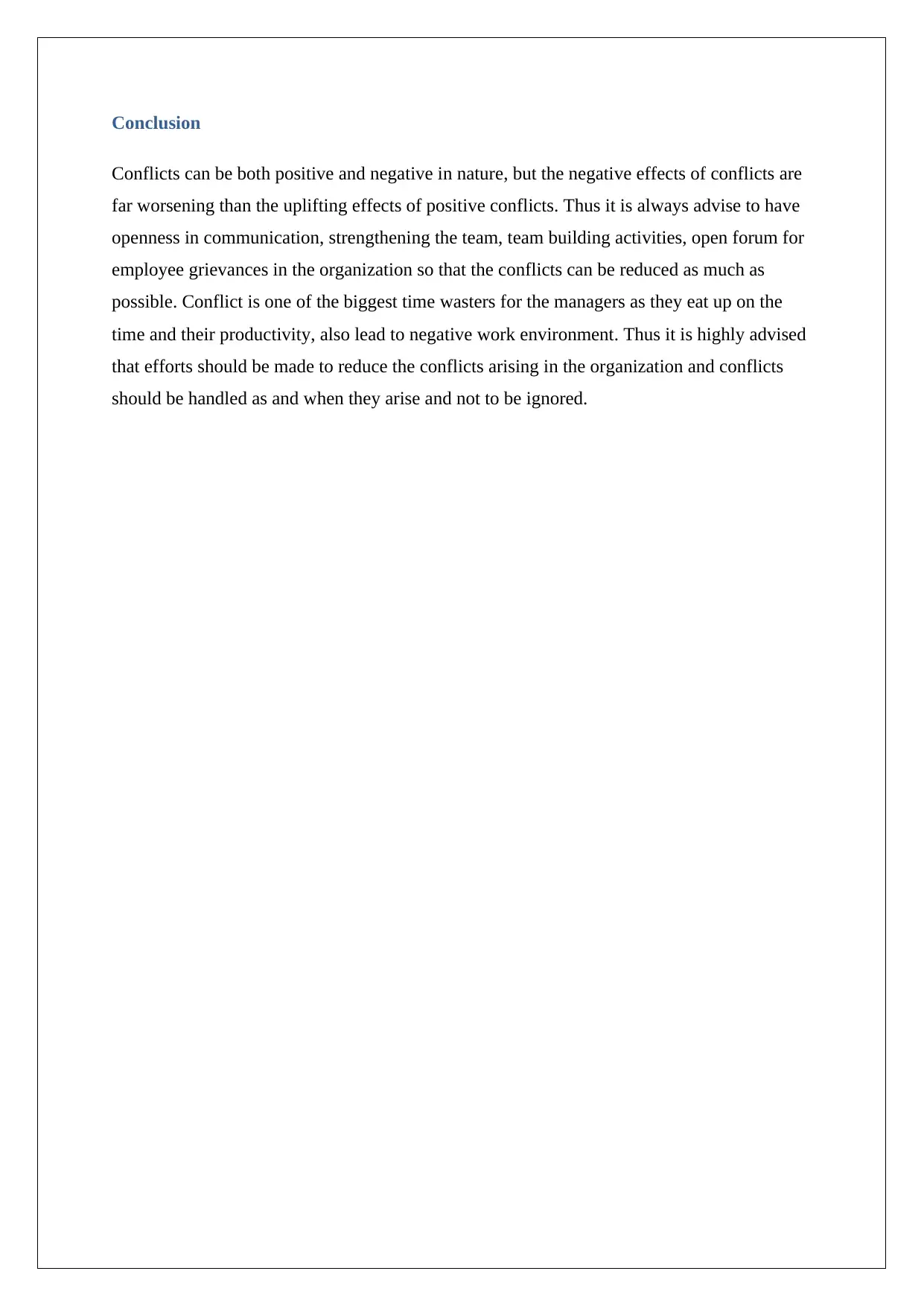
Conclusion
Conflicts can be both positive and negative in nature, but the negative effects of conflicts are
far worsening than the uplifting effects of positive conflicts. Thus it is always advise to have
openness in communication, strengthening the team, team building activities, open forum for
employee grievances in the organization so that the conflicts can be reduced as much as
possible. Conflict is one of the biggest time wasters for the managers as they eat up on the
time and their productivity, also lead to negative work environment. Thus it is highly advised
that efforts should be made to reduce the conflicts arising in the organization and conflicts
should be handled as and when they arise and not to be ignored.
Conflicts can be both positive and negative in nature, but the negative effects of conflicts are
far worsening than the uplifting effects of positive conflicts. Thus it is always advise to have
openness in communication, strengthening the team, team building activities, open forum for
employee grievances in the organization so that the conflicts can be reduced as much as
possible. Conflict is one of the biggest time wasters for the managers as they eat up on the
time and their productivity, also lead to negative work environment. Thus it is highly advised
that efforts should be made to reduce the conflicts arising in the organization and conflicts
should be handled as and when they arise and not to be ignored.
⊘ This is a preview!⊘
Do you want full access?
Subscribe today to unlock all pages.

Trusted by 1+ million students worldwide
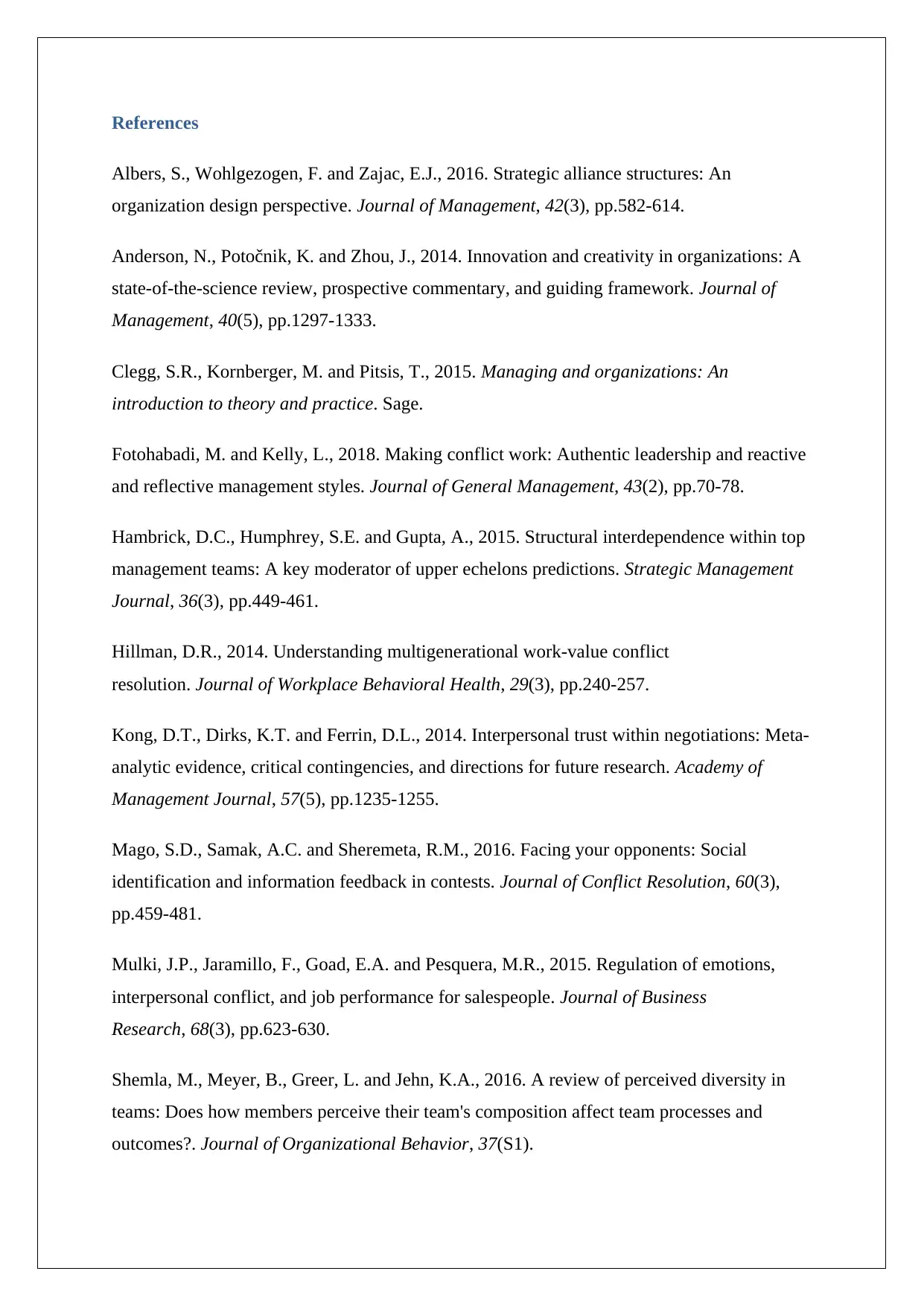
References
Albers, S., Wohlgezogen, F. and Zajac, E.J., 2016. Strategic alliance structures: An
organization design perspective. Journal of Management, 42(3), pp.582-614.
Anderson, N., Potočnik, K. and Zhou, J., 2014. Innovation and creativity in organizations: A
state-of-the-science review, prospective commentary, and guiding framework. Journal of
Management, 40(5), pp.1297-1333.
Clegg, S.R., Kornberger, M. and Pitsis, T., 2015. Managing and organizations: An
introduction to theory and practice. Sage.
Fotohabadi, M. and Kelly, L., 2018. Making conflict work: Authentic leadership and reactive
and reflective management styles. Journal of General Management, 43(2), pp.70-78.
Hambrick, D.C., Humphrey, S.E. and Gupta, A., 2015. Structural interdependence within top
management teams: A key moderator of upper echelons predictions. Strategic Management
Journal, 36(3), pp.449-461.
Hillman, D.R., 2014. Understanding multigenerational work-value conflict
resolution. Journal of Workplace Behavioral Health, 29(3), pp.240-257.
Kong, D.T., Dirks, K.T. and Ferrin, D.L., 2014. Interpersonal trust within negotiations: Meta-
analytic evidence, critical contingencies, and directions for future research. Academy of
Management Journal, 57(5), pp.1235-1255.
Mago, S.D., Samak, A.C. and Sheremeta, R.M., 2016. Facing your opponents: Social
identification and information feedback in contests. Journal of Conflict Resolution, 60(3),
pp.459-481.
Mulki, J.P., Jaramillo, F., Goad, E.A. and Pesquera, M.R., 2015. Regulation of emotions,
interpersonal conflict, and job performance for salespeople. Journal of Business
Research, 68(3), pp.623-630.
Shemla, M., Meyer, B., Greer, L. and Jehn, K.A., 2016. A review of perceived diversity in
teams: Does how members perceive their team's composition affect team processes and
outcomes?. Journal of Organizational Behavior, 37(S1).
Albers, S., Wohlgezogen, F. and Zajac, E.J., 2016. Strategic alliance structures: An
organization design perspective. Journal of Management, 42(3), pp.582-614.
Anderson, N., Potočnik, K. and Zhou, J., 2014. Innovation and creativity in organizations: A
state-of-the-science review, prospective commentary, and guiding framework. Journal of
Management, 40(5), pp.1297-1333.
Clegg, S.R., Kornberger, M. and Pitsis, T., 2015. Managing and organizations: An
introduction to theory and practice. Sage.
Fotohabadi, M. and Kelly, L., 2018. Making conflict work: Authentic leadership and reactive
and reflective management styles. Journal of General Management, 43(2), pp.70-78.
Hambrick, D.C., Humphrey, S.E. and Gupta, A., 2015. Structural interdependence within top
management teams: A key moderator of upper echelons predictions. Strategic Management
Journal, 36(3), pp.449-461.
Hillman, D.R., 2014. Understanding multigenerational work-value conflict
resolution. Journal of Workplace Behavioral Health, 29(3), pp.240-257.
Kong, D.T., Dirks, K.T. and Ferrin, D.L., 2014. Interpersonal trust within negotiations: Meta-
analytic evidence, critical contingencies, and directions for future research. Academy of
Management Journal, 57(5), pp.1235-1255.
Mago, S.D., Samak, A.C. and Sheremeta, R.M., 2016. Facing your opponents: Social
identification and information feedback in contests. Journal of Conflict Resolution, 60(3),
pp.459-481.
Mulki, J.P., Jaramillo, F., Goad, E.A. and Pesquera, M.R., 2015. Regulation of emotions,
interpersonal conflict, and job performance for salespeople. Journal of Business
Research, 68(3), pp.623-630.
Shemla, M., Meyer, B., Greer, L. and Jehn, K.A., 2016. A review of perceived diversity in
teams: Does how members perceive their team's composition affect team processes and
outcomes?. Journal of Organizational Behavior, 37(S1).
Paraphrase This Document
Need a fresh take? Get an instant paraphrase of this document with our AI Paraphraser
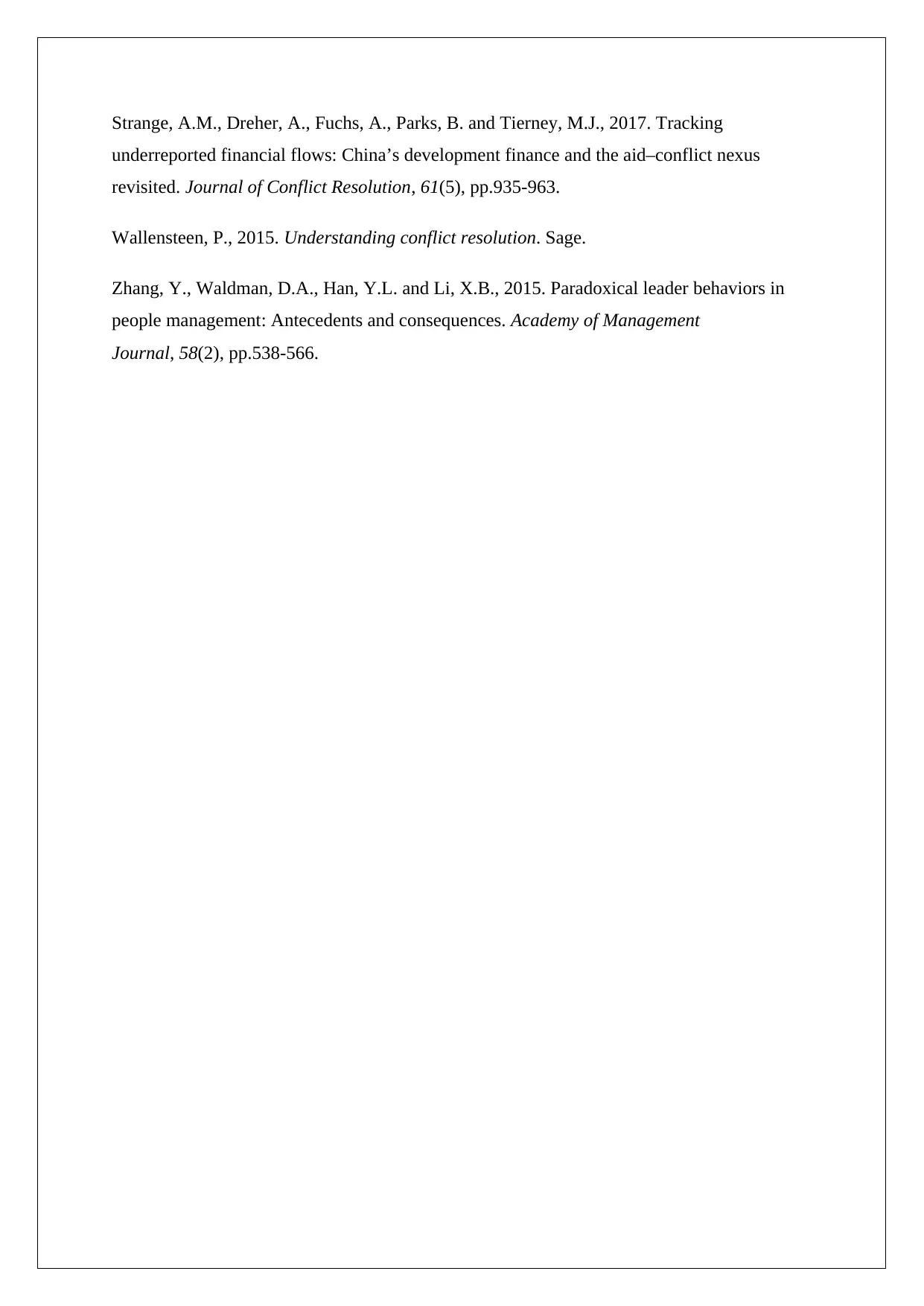
Strange, A.M., Dreher, A., Fuchs, A., Parks, B. and Tierney, M.J., 2017. Tracking
underreported financial flows: China’s development finance and the aid–conflict nexus
revisited. Journal of Conflict Resolution, 61(5), pp.935-963.
Wallensteen, P., 2015. Understanding conflict resolution. Sage.
Zhang, Y., Waldman, D.A., Han, Y.L. and Li, X.B., 2015. Paradoxical leader behaviors in
people management: Antecedents and consequences. Academy of Management
Journal, 58(2), pp.538-566.
underreported financial flows: China’s development finance and the aid–conflict nexus
revisited. Journal of Conflict Resolution, 61(5), pp.935-963.
Wallensteen, P., 2015. Understanding conflict resolution. Sage.
Zhang, Y., Waldman, D.A., Han, Y.L. and Li, X.B., 2015. Paradoxical leader behaviors in
people management: Antecedents and consequences. Academy of Management
Journal, 58(2), pp.538-566.
1 out of 11
Related Documents
Your All-in-One AI-Powered Toolkit for Academic Success.
+13062052269
info@desklib.com
Available 24*7 on WhatsApp / Email
![[object Object]](/_next/static/media/star-bottom.7253800d.svg)
Unlock your academic potential
Copyright © 2020–2025 A2Z Services. All Rights Reserved. Developed and managed by ZUCOL.





